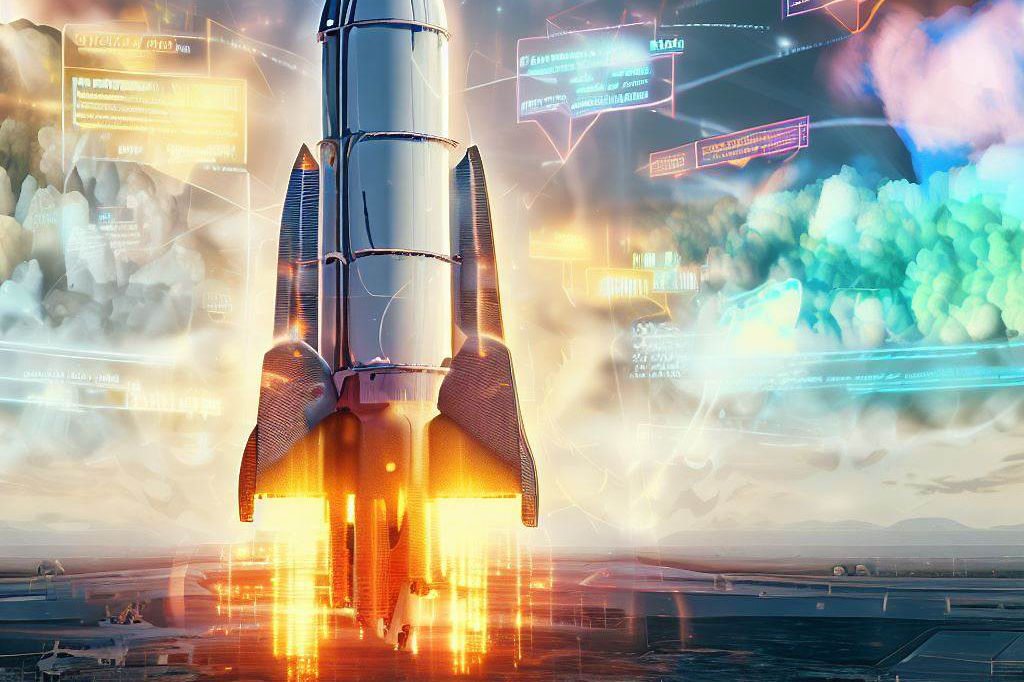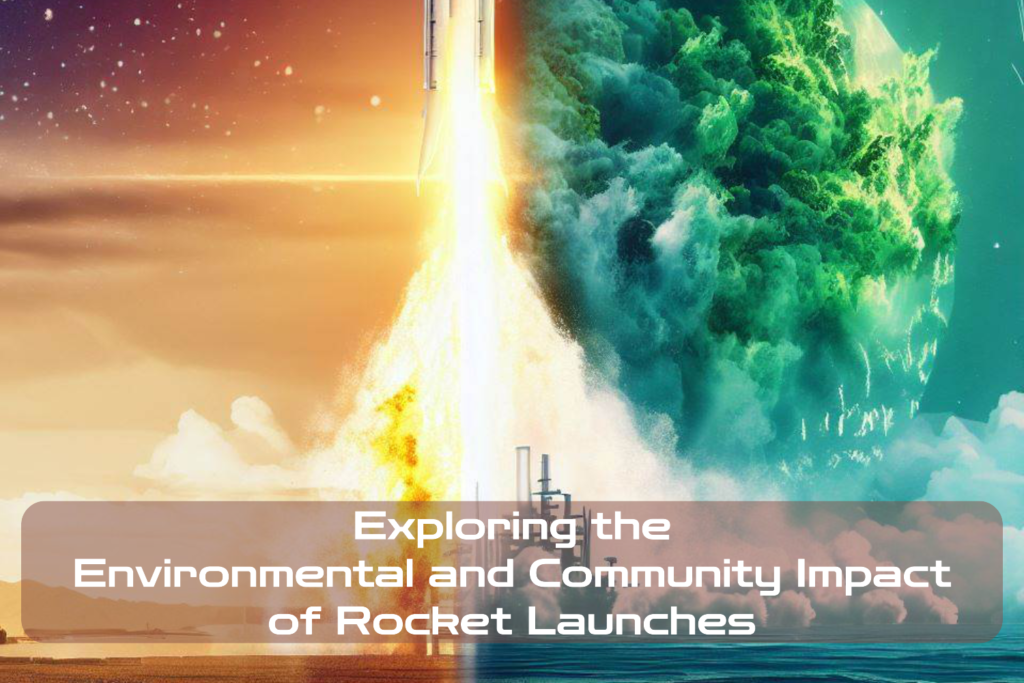The Rise of Rocket Launches: Examining the Impact on Our Environment and Communities
Rocket launches have become an increasingly common occurrence in recent years. With the booming space industry and increased government spending on space exploration, rocket launches are happening more frequently than ever before.
But as we continue to send more rockets into space, it’s important to examine the impact that this has on our environment and local communities. Rocket launches involve a variety of hazardous substances that can have negative effects on both the environment and human health.
The fuel used to power rockets includes toxic chemicals like hydrazine, which can cause serious health problems when exposed to humans or wildlife.
In addition to these toxic chemicals, rocket launches also produce a large amount of greenhouse gas emissions that contribute to climate change.
This is why it’s crucial for us to study and understand the environmental impact of rocket launches. As we continue to rely on these launches for scientific research and exploration, we must do so in a way that minimizes harm to our planet.
Ignoring these potential environmental consequences could result in long-lasting damage that affects not only our immediate surroundings but also future generations. Examining the impact of rocket launches is not only important from an environmental standpoint but also from a community perspective.
While launch sites can bring economic benefits, they can also disrupt daily life for nearby residents during preparation and launch times. Safety concerns for those living in close proximity are another factor worth considering.
Given all these factors, it is clear that understanding the impact of rocket launches is vital if we want to ensure sustainable space exploration practices while preserving our planet’s health and safety.
Environmental Impact

Emissions from rocket fuel and their effects on air quality
Rocket launches have a significant impact on the environment due to emissions from rocket fuel. The burning of fuel releases various chemicals into the atmosphere, including
- carbon dioxide,
- nitrogen oxides,
- and sulfur dioxide.
These emissions can have detrimental effects on air quality in nearby areas.
For example, during a SpaceX launch in California in 2018, residents reported a strong smell of burnt metal and plastic, and some experienced symptoms such as headaches and nausea.
The release of these chemicals can also contribute to climate change.
Carbon dioxide is a greenhouse gas that traps heat in the atmosphere, which contributes to rising temperatures globally.
Nitrogen oxides can also react with other chemicals in the atmosphere to form ozone, which can harm both humans and plants.
Noise pollution and its impact on wildlife
Rocket launches produce high levels of noise that can be harmful to both humans and wildlife.
Animals living near launch sites may experience stress or changes in behavior due to loud noises that disrupt their habitat or interfere with communication between individuals.
In addition to causing short-term disruptions, long-term exposure to loud noises can cause permanent damage. Studies have shown that whales exposed to sonar can experience hearing loss or damage their internal organs due to rapid pressure changes resulting from sound waves.
Debris from launches and its potential harm to ecosystems
Debris from rocket launches poses a significant threat to ecosystems near launch sites as well as those downrange where rockets drop spent stages or payloads into oceans or other bodies of water.
Space debris includes objects such as
- used rocket stages,
- defunct satellites,
- fragments from explosions or collisions between objects
– all of which pose dangers for spacecraft operating nearby at similar altitudes. This debris can end up polluting bodies of water or disrupting habitats for marine life when it crashes back to Earth.
In 2017, a rocket stage from a Chinese launch fell into the Indian Ocean and polluted the surrounding waters with toxic fuel.
The Local Impact of Rocket Launches

Economic Benefits for Local Communities
Rocket launches can have a significant positive impact on the economies of nearby communities. With each launch, there is an influx of people who come to view the event or participate in related activities, such as tourism or research.
This increase in visitors provides a boost to local businesses such as hotels, restaurants, and souvenir shops. In addition, rocket launches create job opportunities for locals who may work in support roles such as maintenance or security.
Furthermore, the presence of space agencies and aerospace companies conducting research and development also brings jobs and investment to the area. These companies require skilled professionals in fields such as engineering and science.
Disruption to Daily Life During Launch Preparations and Actual Launch
While rocket launches can provide economic benefits, they also disrupt daily life for local residents.
Preparation for a launch typically involves road closures and increased traffic congestion near launch sites.
This can make it difficult for residents to commute or travel through affected areas.
During actual launch events, there is often a mandatory evacuation zone established around the site due to potential safety concerns (more on that below). This means that nearby residents must temporarily vacate their homes until after the launch has occurred.
Potential Safety Concerns for Nearby Residents
Safety concerns are another issue that must be considered with rocket launches.
The rockets themselves contain hazardous materials that could pose health risks if they leaked into surrounding areas.
Additionally, there is always a chance of accidents occurring during preparation or launch.
For example, during the 1986 Challenger disaster at Cape Canaveral in Florida, debris from the shuttle fell into nearby residential areas, causing damage and injury.
While incidents like this are rare, it is important that proper safety procedures are followed to reduce risk as much as possible.
Despite these challenges, many local communities see rocket launches as a source of pride and excitement. They recognize the economic benefits and are willing to tolerate the disruptions to daily life in exchange for the opportunity to witness history being made.
The Impact of Rocket Launches on Specific Locations

Cape Canaveral, Florida: The Home of American Spaceflight
Cape Canaveral Space Force Station and Kennedy Space Center have been the home of American spaceflight for decades. With numerous launches each year, the impact on the environment and local communities is significant.
The emissions from rocket fuel have led to air quality concerns in the surrounding areas, leading to initiatives from NASA and other agencies to reduce harmful effects through cleaner fuels and improved launch practices.
The noise pollution from launches can also be felt throughout the area, impacting wildlife habitats nearby.
Despite these concerns, rocket launches remain a major economic driver for the region, bringing in tourists and supporting local businesses. However, there have been instances of road closures and other disruptions during launch preparations that have caused inconvenience for residents.
Baikonur Cosmodrome: A Legacy of Launches
Baikonur Cosmodrome in Kazakhstan is one of the oldest spaceports in the world with a legacy dating back to Soviet times. Today, it hosts numerous launches each year by Russia’s Roscosmos space agency as well as commercial operators such as SpaceX. The impact on local communities has been significant, with air quality concerns due to emissions from rocket fuel being a major issue.
While Baikonur is located in a remote part of Kazakhstan far from major population centers, there have still been instances where debris or discarded rocket parts have landed near communities, causing both economic damage and safety concerns.
Despite these challenges, Roscosmos has worked to mitigate harmful effects through outreach programs aimed at informing locals about launch schedules and safety procedures.
Wallops Island: A Growing Hub for Commercial Launches
Wallops Island Flight Facility located off Virginia’s Eastern Shore, has become an increasingly important hub for commercial space launches in recent years, with numerous companies utilizing the site for their missions. The impact on the environment and local communities has been studied closely, with air quality concerns being a major focus. However, the growing presence of commercial spaceflight could ultimately lead to increased economic benefits for the surrounding region.
With a growing demand for smaller, more affordable launches, Wallops Island is positioned to remain relevant in the years ahead. Despite these benefits, it remains important to consider and address any negative impacts on local communities and the environment.
Mitigating Negative Effects

Efforts by Space Agencies to Reduce Environmental Impact
While rocket launches have a significant impact on the environment and local communities, space agencies have made efforts to reduce their negative effects.
One way they are doing this is through the use of cleaner fuels. Traditionally, rockets have used highly toxic fuels such as hydrazine and nitrogen tetroxide.
However, newer rockets are being designed to use alternative fuels that produce fewer emissions and are less harmful to the environment.
For example, SpaceX’s Falcon 9 rocket uses liquid oxygen as its oxidizer and RP-1 kerosene as its fuel.
In addition to using cleaner fuels, space agencies are also implementing better launch practices. This includes optimizing launch trajectories to minimize the amount of time spent in Earth’s atmosphere and therefore reduce emissions.
They are also developing reusable rockets that can land safely back on Earth after launching satellites or other payloads into space. This not only reduces emissions but also lowers the cost of launches.
Community Outreach Programs
Space agencies recognize that rocket launches can be disruptive for nearby communities, so they have implemented community outreach programs in an effort to address concerns and provide education about launch activities. These programs include town hall meetings where residents can voice their concerns about safety or noise pollution from rocket launches.
Some space agencies also offer tours of launch facilities so that members of the public can see firsthand how rockets are prepared for launch and learn more about the science behind it all. This helps create a sense of transparency between space agencies and local communities.
Some space agencies work with local schools or universities to provide educational opportunities for students interested in science or engineering fields related to rocketry. For example, NASA’s “Rocket University” program offers training courses for students interested in learning about rocket propulsion systems.
Overall, while there is still much work to be done to mitigate the negative effects of rocket launches on the environment and local communities, space agencies are making significant strides in this area. By using cleaner fuels and better launch practices, as well as implementing community outreach programs, they are creating a more sustainable and transparent approach to rocket launches.
Final Thoughts

While there are challenges facing us as we look towards an increasingly space-faring future, there is cause for optimism. With continued attention to environmental impact and community well-being, we can work toward a more sustainable approach to space travel that benefits all parties involved – from scientists conducting research in orbit to nearby residents enjoying a higher quality of life.
Ultimately, striking a balance between progress in space exploration and responsible environmental stewardship will be key to ensuring a brighter future for generations to come.

C M, a seasoned editor, journalist, and consultant, is deeply fascinated by the convergence of technology, space, and the future of humanity.
With a particular interest in transhumanity, futurology, and the philosophical and ethical dimensions of these domains, C M serves as the lead contributor to SpaceSpotlight and TranscendSphere.
When not penning insightful articles on these rapidly evolving fields, C M indulges in their love for podcasts and books, proudly embracing their status as a ‘Happy Nerd Extraordinaire!’



